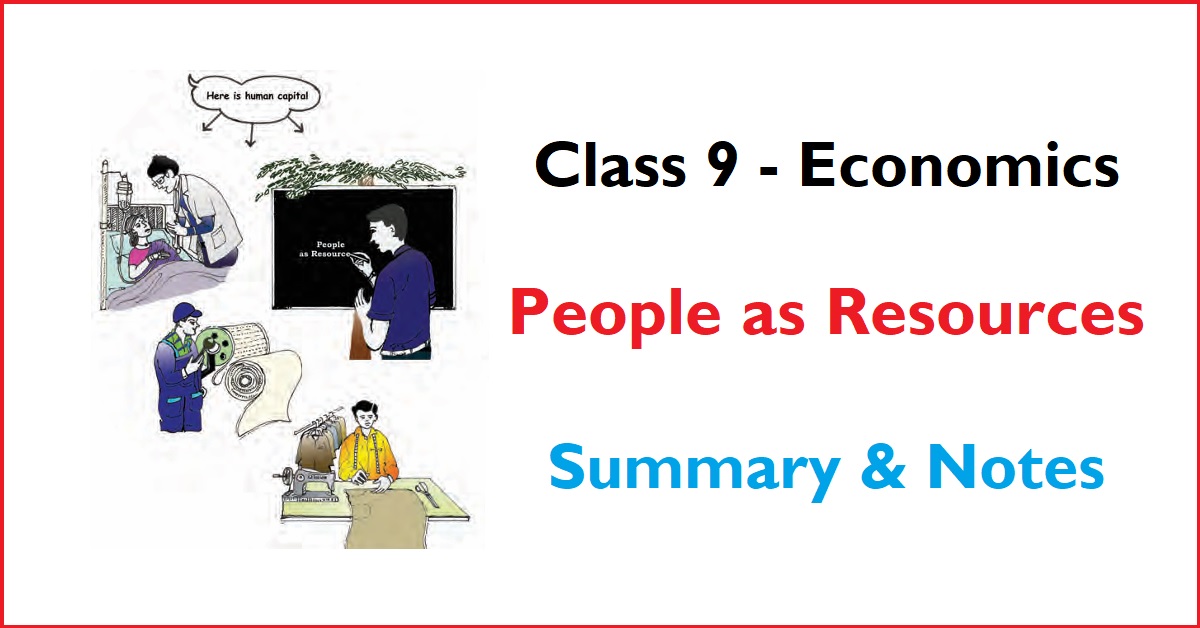People as Resource Summary Notes – Easy Explanation
Dear students, in this post we will try to understand Class 9 Economics Chapter 2: People as Resource, here you will get summary and notes. Reading this. you will easily be able to get idea what this chapter is all about.

1. Concept of People as Resource
- The chapter explains how population can be an asset (resource) if proper investment is made in education, health, and skill development.
- This leads to the formation of human capital, which plays a vital role in economic development.
2. Human Capital Formation
- Investment in people leads to increased productivity, efficiency, and income.
- Examples: India’s Green Revolution and IT Revolution show how skill and knowledge transformed sectors.
3. Case Studies: Sakal and Vilas
- Sakal: Educated and trained, got a job, increased firm productivity, received promotion.
- Vilas: Poor, unhealthy, uneducated, did low-income work.
- Lesson: Investment in education and health creates a virtuous cycle; lack of it creates a vicious cycle.
4. Economic Activities
- Divided into three sectors:
- Primary: Agriculture, fishing, mining.
- Secondary: Manufacturing.
- Tertiary: Services like transport, banking, education.
- Two types:
- Market activities: For income/profit.
- Non-market activities: For self-consumption, like household chores.
5. Role of Education
- Education improves employment opportunities, income, and quality of life.
- Literate parents tend to invest more in their children’s education.
- Government initiatives: Sarva Shiksha Abhiyan, Mid-Day Meal, vocational streams, Navodaya Vidyalayas.
6. Role of Health
- Good health increases productivity and life expectancy.
- Health statistics:
- Infant mortality rate: 147 (1951) → 28 (2020).
- Life expectancy: 67.2 years (2021).
- Government has expanded health services and personnel over the decades.
7. Unemployment
- Defined as the situation when people are willing to work at the prevailing wages but cannot find jobs.
- Types of unemployment:
- Seasonal: In agriculture during non-peak seasons.
- Disguised: More people employed than needed, especially in family farms.
- Educated unemployment: Degree holders without suitable jobs.
- Consequences: Wastage of resources, poverty, mental stress, social unrest.
8. Women and Work
- Women often do unpaid household work not counted in national income.
- In the workforce, they generally receive lower wages due to low skill and education levels.
- Educated and skilled women are equally paid in professional sectors like medicine and teaching.
9. Quality of Population
- Depends on:
- Literacy rate
- Health (life expectancy)
- Skill formation
- High-quality population drives national growth and prosperity.
10. Village Story: From No Jobs to Many
- A family sends a child to agriculture college → returns as agro-engineer → designs better tools → boosts farm productivity.
- School established in the village → more children educated → jobs like tailoring, teaching created.
- Outcome: The village transforms into a thriving economy due to rising human capital.
Final Summary
People are valuable national resources when properly nurtured through education and health.
Economic growth, productivity, and employment depend on how well the population is developed into human capital.
Pages: 1 2
Pingback: The Story of Village Palampur: Summary & Notes
Pingback: Poverty as a Challenge Summary Easy Explanation